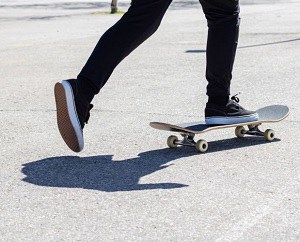If trying something for the first time, whether sports, crafts, or other possible hobbies, we often find them tough or challenging. But that’s what makes pursuing our passion more fulfilling.
Let’s have skateboarding, for example. On the first few days, beginners would wonder, “why is skateboarding so hard?”. But the story would not be the same once they find their groove and establish their learning curves.
Skateboarding can be tough for the novice because it calls for full body coordination, the ability to balance well, and the courage to carry on despite the risks of falling or injuries.
Read on to find out more about the challenges this sport presents and what we can do to counter them.
Table of Contents
Reasons Why Skateboarding Can Be Tricky
Many people claim that skateboarding is the hardest sport to learn. Such is because of the complexity of tricks and stunts and the constant need to balance on the board.
But while these reasons aren’t wrong, let’s first identify what stops potential skating professionals.
1. Skateboarding entails working with your upper and lower body.
You have to make these work like a cohesive unit. Remember when skateboarding tricks tutorials tell you to angle your body to this side or that to ensure you won’t fall? That’s the coordination needed.
Note that even the simplest skateboarding trick would require body coordination and proper weight distribution. Some harder stunts, such as the Gazelle flips, demand such excellent dexterity that even one wrong posture, however small, can ruin the whole trick.
Age is also related to dexterity – older people will have a harder time controlling their limbs and body posture.
2. Balance is essential.
This is arguably one of the most challenging parts of skateboarding for beginners, as they are supposed to balance on a constantly moving board. Aside from the stances that need mastering, a skater is also supposed to learn how to shift their weight to steer without losing their balance.
The limited stepping surface can also seem daunting for beginners–even one small wrong step can mean they’ll fall off the small skateboard. Its trucks’ tightness level could make things shaky and, thus, more challenging to keep balance.
3. Skateboarding needs a sufficient driving force.
Except for those using an e-skateboard, most will have to rely on their legs to generate a propelling force to push themselves forward.
Let’s begin with the basics, pushing. You won’t encounter a downward-sloping road all the time. What happens if you skate on a slightly uphill trail or a flat one?
The takeaway here is: you need to be strong enough to be able to push yourself forward with just one leg. And that’s just the tip of the iceberg – performing tricks is even more physically taxing.
4. This sport requires mental toughness.
When it comes to learning how to skateboard, mistakes are virtually unavoidable. No matter how other sugarcoats it, you’re bound to trip or fall at one point or another.
While proper protective gear will ensure that you won’t be injured (or at least severely so), the prospect of falling or getting wounded is indeed scary. This mental obstacle can become so much of a nuisance that beginners may quit for fear of falling.
If you ever get scared or disheartened, remember how professionals and famous names in the sport once had bruises and injuries landing verts or grinding rails.
How Hard is Skateboarding?
Is skateboarding hard to learn? Notwithstanding people’s claims, let us help you gauge the sport’s difficulty through the following points.
1. Pushing alone may take a few weeks to a month.
Depending on the practice’s frequency, it’ll take an average beginner one month to learn to push on the board. Mastery will take another month or two to manifest.
2. Primary tricks will consume three to six months to learn.
What are the fundamental tricks in skateboarding? These are the ollies, pop shuvits, kick turns, backside 180, and the like.
Forgive yourself if you still make mistakes doing these in the specified time. Because often, a few months of practicing these skills can only, at best, help you get the hang of them. For mastery, it can take up to a year of constant practicing.
The more difficult skateboard tricks, however, can take even longer to learn. For instance, the Gazelle flips may require several years for actual proficiency. The 900 is another trick that not many skateboarders can claim to master, no matter how experienced they are at the sport.
Hardest Tricks in Skateboarding
We just mentioned how much time the basic skills in this sport take. But moving forward, what are the hardest skate tricks one could ever perform?
- Backside Tailslide
- Laser Flip Skateboard
- The 900
- Tre Gazelle Flip
- Impossible Skateboard Trick
Time to Get Good at Skateboarding
Now, how should we prepare for skateboarding? What is the best approach to mastering all the elements? How long does it take to get good at skateboarding? Check this summary.
Learning Schedule for Beginners
Have you finally decided to start? Here’s what you can do in 60 minutes. You can adjust your durations, but try to keep them in this proportion.
| Skill | Minimum time required | What to do |
| Balance | 10 minutes |
|
| Pushing | 30 minutes |
|
| Carving | 15 minutes |
|
| Stopping | 5 minutes |
|
Frequently Asked Questions
Is skateboarding mostly mental?
We mentioned how the mind could drift us into thinking it’s hard to skateboard, we can’t perform this trick, or we will land badly. So in a sense, skateboarding is indeed mental. But just because it’s what the brain tells us does not mean we won’t overcome it.
Realistically, we can divert negative mental energy into positive ones. We should think of the sport’s cognitive benefits. These perks include relieving stress, gaining friends, and awakening creativity.
In skateboarding, you can also improve your mental toughness, confidence, and overall lifestyle. Eventually, you’ll be able to share with the young ones what it’s like to skateboard.
Do skaters get hurt a lot?
Like any other physical sport, there is always a risk of injuries in skateboarding. But how hurt do skaters get?
The usual injuries that happen to skateboarders are the following:
- Arm and leg fractures and dislocations
- Neck and trunk strains
- Facial injuries
- Head concussions
Of course, bruises and other minor mishaps still happen. But overall, there are only averaging 70,000 reported injuries each year. Out of millions of skateboarders today, the numbers are not significant.
However, these numbers and circumstances do not necessarily mean we should neglect our safety. If we want to be masters, we should also be vigilant of the things that make skateboarding dangerous.
Conclusion
Nothing is as sweet as a hard-earned milestone. The process might be rough, but it’s what molds us to be better. Like in skateboarding, balancing, pushing, and landing tricks are only a few things we’ll encounter in the journey.
But in the end, we’ll see ourselves learning and mastering all these skills. So, the next time you ask, “why is skateboarding so hard?” remind yourself it will be smoother one day. Trust the process, and it’ll repay you.
Are you starting skateboarding today? Check all the timelines and considerations, and unleash that skateboarder in you.

Hi, I am Charles Harris. I opened this site to write as much as I can about my biggest passion – skateboarding!
I started as a clumsy yet passionate rookie 10 years ago to now a still passionate yet much better skateboarder! But I have to tell you, the whole journey has always been fun and rewarding, indeed not without hardship.










